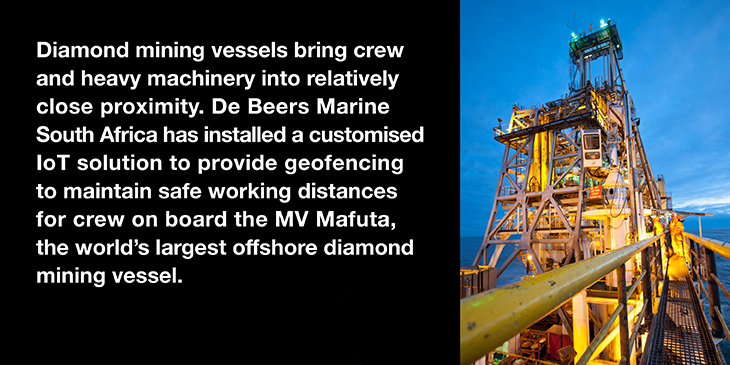Despite considerable efforts in many countries, mining continues to be a hazardous occupation. According to the International Council on Mining and Metals (ICMM) figures released on safety for its members last year, there were 287 fatalities, a marked increase of the 50 fatalities recorded in 2018. This was partly due to the catastrophic collapse of a tailings dam at a mine in Brumadinho, Brazil, which cost 250 lives.
The ICMM recognizes that progress has been made in occupational health and safety across the mining industry, but that more needs to be done. It calls for a zero-harm approach designed to operate without exposing workers to injury through the deployment of safe work tools. The organization sees technology as a key enabler for zero-harm and makes several recommendations, including sharing technology pilot results and encouraging more rapid uptake of technology applications. This includes hazard controls such as geofencing.
Geofencing keeps miners safe
Geofencing is a virtual boundary drawn around a dangerous area. This can be achieved with GPS and other data signals including cellular, Wi-Fi and RFID. The idea being that a geofencing application responds instantly when a mobile device enters or leaves the fenced area. It can limit personnel access to recently blasted areas, for example, or minimize the time for evacuation due to an explosion by determining the best escape routes.
A geofencing application can be programmed to set off an alarm on a mobile device if a worker or vehicle operates too close to the edge of a dangerous boundary. As an extra failsafe, the technology can automatically shut down dangerous equipment or alert site managers so that they can take decisive action quickly.
Coupled with telematics, geofencing can track the whereabouts of assets and prevent them from leaving a defined area. Telematics is the technology used to track individual machines or a fleet. Telematics collects data from vehicles, including location, driver behavior and vehicle activity.
It can help management keep track of heavy machinery assets and keep them out of hazardous environments, for example. If a machine handler is behaving erratically and endangering the safety of others, an alert can be sent to the site manager.
Beacons help track miners
Smart beacon systems with Bluetooth sensors record data wirelessly based on proximity. They consist of a radio, processor and battery and continuously transmit Bluetooth low-energy signals. These beacons can be used to protect miners by tracking changes in the environment, such as alerting them of potential rockslides. These sensors can also track miners entering and exiting mines at a set location in real time.
Mobile beacons can also be worn on the miner’s wrist or helmet, allowing for individual miner monitoring. Locator nodes and gateways can be housed in specific strategic locations. Gateways are designed to collect data wirelessly from Bluetooth Low Energy Beacons and then transfer it to the cloud via Ethernet, Wi-Fi or GSM/mobile wireless networks. Such a system can alert miners if they trespass into a danger zone, for example. It also provides management with instant visibility on location, effectively managing an evacuation if required.
Smarter mining will improve safety
Geofencing is just one of the digital technologies that is already having a major impact on the mining industry. The global smart mining industry generated $9.25 billion in 2019 and is forecast to hit $24 billion by 2027. This is being driven by improved health and safety efforts in mining, alongside increased environmental legislation and the difficulty in attracting skilled labor. Automation will help to address some of these, but miners will continue to be an essential part of the mining process for the foreseeable future.
Emerging technologies, such as artificial intelligence (AI) and machine learning (ML), for example, are also helping to improve safety. Data harvested from geofencing sensors, for example, can be used to find patterns in sites that have had breaches in dangerous zones or high levels of accidents to better understand how safety can be improved.
Mining companies are also employing body suits with haptic technology connected to beacons. Haptic technology uses touch to alert its wearers and will be enabled by the speed and capacity of 5G. Haptic technology has the potential to give miners tangible, early warnings on potential accidents in high-risk mining environments.
Safety at sea
Geofencing can keep miners safe underground, over ground or at sea. For example, Orange Business recently partnered with diamond miner De Beers to install and test a customized geofencing solution to keep its marine diamond mining crew safe offshore.

The solution has been piloted successfully onboard MV Mafuta, the world’s largest diamond mining vessel, which operates up to 150km off the coast of Namibia. The project uses Internet of Things (IoT) technologies and wearable sensors to monitor crew proximity to heavy machinery to ensure they stay safe.
As part of the pilot, Orange imported the vessel’s AutoCAD files and carried out an onboard site survey to map antenna locations to geofence a predetermined area on the vessel. Crew members were given wrist sensors. If one of the crew breached the geofenced area on the vessel, the ship’s bridge was immediately alerted.
“We are constantly looking at new ways of enhancing employee safety, especially around the heavy machinery required for diamond operations,” explains Gerhardus Theron, Vessel Manager of the MV Mafuta.
A future of change
The Intergovernmental Forum on Mining, Minerals, Metals, and Sustainable Development (IGF) recommends that permanent new health and safety protocols must be put in place with more significant investment in protective equipment and technologies.
As mines get deeper and more remote, miner well-being and safety will be a critical priority alongside productivity. Technology will be paramount in addressing these challenges going forward.
Read the press release about De Beers co-innovating a geofencing solution to enhance crew safety in offshore mining.